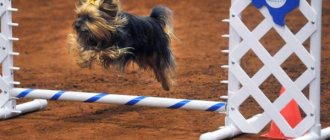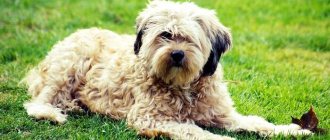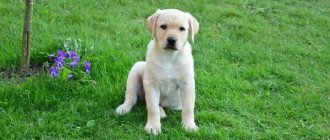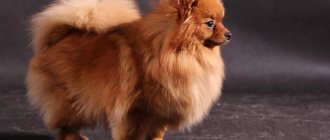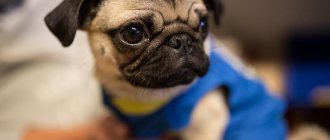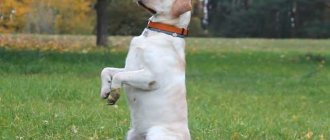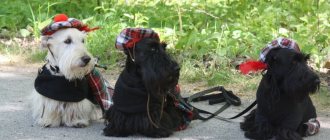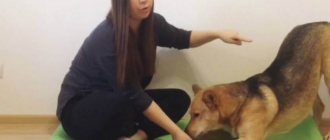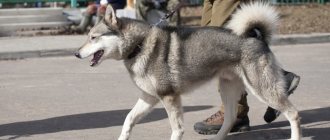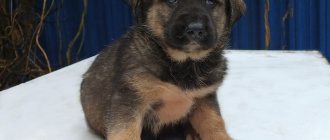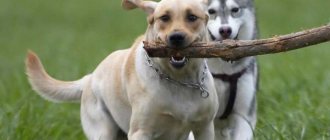The homeland of the Rottweiler is the city of Rottweil, in southern Germany. Since ancient times, strong, hardy dogs have been used to guard and herd cattle. In addition, dogs have excellent fighting qualities, so they are often used as guards.
But, unfortunately, due to the fault of inept owners, the Rottweiler began to be considered an aggressive animal, a killing machine. In fact, these are offensive and unfair definitions.
With proper upbringing, a Rottweiler grows into an intelligent, calm, loyal pet.
Is it possible to train a Rottweiler?
Dog trainers and experienced breeders say that training a Rottweiler is not an easy task. The dog, by his nature, cannot grasp everything on the fly, but what he has learned remains in his memory for the rest of his life.
The success of training and the subsequent behavior of the Rottweiler depends entirely on the skills of the owner himself. The qualities of the owner play an important role: he must have patience, perseverance, self-confidence, and rigor.
A weak-willed and weak-willed person will suffer from the antics of a maturing animal and, ultimately, this can turn into a tragedy.
Mistakes should not be made when raising a Rottweiler. The right approach, knowledge of the main character traits and developmental features of the dog are prerequisites for anyone who decides to keep and raise a Rottweiler.
If you follow all the rules and recommendations, you will grow up to be a devoted friend, an excellent protector and guard.
Tips from a dog handler
It should be remembered that Rottweilers have good intelligence and are easy to train. However, there is also a negative side of this breed - it is a slow reaction. Accordingly, a person needs to be patient when it comes to learning.
Attention! You can’t break down, much less beat an animal.
Each task is studied until the dog masters it. A significant advantage is that the Rottweiler will never forget a learned skill and will always perform it.
As you can understand, training is a complex process that requires a lot of dedication from both the dog and the person. If everything is done correctly, the animal will learn the necessary commands and will delight the owner with its obedience.
Character and temperament
The Rottweiler is deadly to ill-wishers and absolutely affectionate and flexible with members of its family. Has an independent character and a strong sense of self-esteem. Self-assured. Constantly strives to prove his leadership. Next to such an animal there must be a strong-willed owner.
If the owner manages to take a dominant position in the relationship with the pet, then the dog will become obedient, understanding and loyal.
Having a lively temperament, the Rottweiler needs dynamic, outdoor games. While walking with your dog, you can go cycling or just jogging so that the animal’s energy goes into an active lifestyle. Then the pet will become calmer and control over it will be easier.
When raising and training a Rottweiler, it is recommended to take into account the following characteristics of the breed:
- Fighting spirit - the massive jaw and strong muscles of the animal are ready for battle at any moment.
- Obedience is a wayward, independent creature that, with the right approach, easily makes contact with its owner.
- Self-control - an unrestrained and nervous state is not characteristic of the fighting Rottweiler. An unfamiliar atmosphere will not frighten him.
A properly raised Rottweiler is balanced and friendly. Some breeders strive to specifically develop aggression in a dog. However, this is a huge mistake. In the future, it will be difficult to stop the hostility and outbursts of anger of a temperamental animal.
Need to know! A special feature of the Rottweiler breed is its slow reaction time. The transition from one state to another is inhibited in these dogs. When training a Rottweiler, you should take this nuance into account and not get irritated. Otherwise, you may encounter uncontrollable aggression in your pet.
Manageable city dog
If there is no opportunity or desire to take official exams on a general training course with your Rottweiler, you can train your Rottweiler in the UGS course - a controlled city dog. Unlike OKD, where the assessment of completed tasks will be given by specialists of the Russian Canine Federation, the UGS course is held in any dog breeding club. Therefore, instead of an RKF certificate, the owner of a Rottweiler can only receive a club diploma.
Taking a city dog management course is especially recommended for owners who live in the city and constantly appear with their Rottweiler in public places. Training begins at six months.
The UGS course is designed to develop a Rottweiler into a companion who knows how to behave correctly in city conditions. However, there are more requirements in this course than in OKD. After all, work with dogs is carried out not only in closed dog parks, but also in other areas where there are many unpredictable urban factors and outsiders.
After completing the UGS course, the Rottweiler will learn the following:
- follow the commands “near”, “sit”, “lie down”, “stand”, “come to me”, “no”, “fu”;
- treat walking accessories calmly: leash, muzzle;
- do not show signs of anxiety during a manual examination of teeth, fur, ears, paws;
- calmly go out or enter the entrance, car, clinic, and so on;
- calmly cross an overground or underground pedestrian crossing;
- be comfortable on public transport;
- do not accept food from strangers;
- do not pick up food or dirty objects from the ground;
- wait for the owner on a leash in public places;
- overcome an obstacle course;
- concentrate attention on the owner;
- do not react to city noises.
In addition to the UGS course, an already one-year-old Rottweiler can take the ZGS course - a protective city dog. In addition to the skills of the dog, the dog will learn to obey while practicing protective functions, to grab an attacker on the command “face” and release on the command “throw it”, to repel an attack on the owner or other family members, to detain and escort an escaping person.
Like the UGS rate, the USG rate is not official. After passing it, the Rottweiler will receive a diploma from the Kennel Club.
Please tell us in the comments how you trained your dog.
If you liked the article, please share it with your friends and like it.
Basic rules of training
From the first day a new four-legged member of the household arrives in the house, you should show the wayward puppy who is boss. Even a small Rottweiler will only listen to the leader.
It is not necessary to use force to demonstrate your dominant role. But the boundaries of what is permitted must be determined immediately.
Dog handlers recommend that novice Rottweiler owners adhere to the basic rules when training at home:
- Having given the dog a command, you need to ensure complete and correct execution. You cannot jump from one command to another: the dog will get confused. The order will lose significance, and the pet will refuse to carry it out.
- The physical and mental condition of the dog is very important. If she is too agitated, anxious, or, conversely, does not take the initiative, you should skip the training and contact the veterinarian.
- If the pet executes a command incorrectly, it means the owner is giving it incorrectly. Commands are given in a clear voice, with a certain strict but calm intonation.
- You cannot demand the impossible from a four-legged pupil. This can tire, frustrate and even anger your dog. The result is disobedience.
- It is unacceptable to deceive an animal. A dog will stop trusting a person if, after the command “Walk!” she will be given an injection. A trusting relationship is the key to mutual understanding and successful education of a Rottweiler.
How long to train
Each training session should be a joy for both the owner and the pet. It is better to train a Rottweiler in the form of a game and always in the air. Work with the puppy 3-4 times a day for 15 minutes.
If the weather is not suitable for training, you can skip it, but then make up for it. For an adult dog, training time increases to 30–40 minutes.
Classes with the pet are carried out in the same secluded place, then the Rottweiler will be less distracted.
Rewards and punishments
When raising and training a sometimes stubborn and willful pet, the carrot and stick principle is suitable. For a correctly completed task, you can treat the Rottweiler with a piece of his favorite treat.
The reaction to food in four-legged gluttons of this breed is amazingly developed. Treats will help reinforce skills and retain them in the animal’s memory.
In addition, food helps keep your dog active after training and helps build a more trusting relationship. Along with treats, the pet is stroked or patted on the back as a reward.
Important! Before training, the Rottweiler is not fed - the dog must be half-starved.
A six-month-old Rottweiler may, showing character, stop listening and following orders. If treats and friendly pats don't help, it's time to punish. The following methods are used:
- lifting the animal low above the ground and lightly shaking it;
- covering the dog's muzzle with your palm for a short time;
- reprimand in a stern and harsh voice;
- lack of encouragement.
Punishment should not be overdone. If you cause an animal severe pain and become angry, the dog may also become angry in response. It will be difficult to control such a Rottweiler.
Each training session should end with a command that the student knows and carries out unquestioningly. Afterwards you need to reward your pet. Then, until the next training session, both participants will have a feeling of success.
What should be prohibited
From a very early age, you need to prohibit your puppy from grabbing and biting someone’s hands. Even in a fit of joy or in a game, this cannot be allowed. Showing aggression towards the owner and other family members in any form is categorically unacceptable.
In the future, this may result in the dog, feeling its strength, becoming uncontrollable.
The pet must learn to communicate with other animals, not offend or bully them, and treat them positively and kindly.
Important! The most important thing is not to allow a small Rottweiler to do things that an adult dog should not do.
Training for walking
You need to do this from a very early age. Teaching an animal to be calm when walking on a leash is a skill that requires knowledge and patience from the owner. Teaching a puppy to a leash goes through the following stages:
- The dog examines and sniffs the leash.
- The owner puts a collar on the puppy so that he gets used to the new accessory.
- The collar is worn every time you get ready for a walk.
Important! It is strictly forbidden to remove the collar if the puppy persistently tries to do it himself. You should calm the dog down, redirect its attention by offering a toy, and only then remove the accessory.
When to start training
The upbringing and training of a dog begins from the first day of its stay in the house. This usually happens within a month or a month and a half. The most suitable age to start training is 2 months. While the puppy is close to its mother, it instinctively acquires the necessary skills.
When a pet falls into human hands, the owner takes responsibility for it and its behavior.
Naturally, the sooner the owner begins to train the animal, the easier it will be to achieve a positive result. However, more mature dogs can also be trained if done correctly. But it’s still better not to delay and start training at the age of 6 weeks to 6 months.
Exhibition training
The dog is prepared for exhibitions from the age of 2-3 months. In most cases, an inexperienced trainer will not cope with the task, since the animal must:
- treat large crowds of people and other dogs calmly;
- run next to the owner for a designated number of laps;
- stand up on demand;
- allow yourself to be examined by judges and experts.
Behavior at exhibitions
Where to start training
The first thing a little Rottweiler must learn is a name. The name is said as often as possible so that the puppy learns to respond. Then the pet begins to distinguish the intonations with which the owner calls him.
A nickname is a special part of upbringing. With its help, the owner guides the pet with shades of voice throughout the entire time.
The next stage is toilet training. At first, the little Rottweiler will leave puddles everywhere. This is not out of harm, but because puppies cannot tolerate it. Where it felt like it, it happened. As soon as the baby begins to spin around and sniff the floor, he is taken to a tray or diaper with the word “toilet.”
If the dog did everything right, he will definitely praise it. Over time, the Rottweiler will begin to independently find a designated place for “its business.”
Obedience training
We need to show the new household member his place. The Rottweiler must know the corner where it is supposed to sleep. They take the pet there several times a day, saying the word “Place!” Soon the pupil will learn to go to the mat not only for rest, but also on command.
It is recommended to place the baby’s favorite toys in the “place”. They will replace the puppy's brothers, and it will be easier to survive separation from his former home.
The command “Eat!” the most beloved and easily accepted by the Rottweiler. But the dog must understand that there is a certain time and designated place for eating. You shouldn’t train your pet to eat whenever you have to. Feeding from the table is also undesirable. Otherwise, the dog will turn into a beggar.
Food is a great incentive for a dog. Once you understand what your dog likes, you can begin learning basic obedience skills, training, and teaching basic commands.
Teaching order in the house
Proper education of a Rottweiler necessarily includes training in order. The puppy must understand:
- You can only play during the day;
- you need to sleep at night;
- You can't howl and bark when you're alone.
- Chewing slippers and pieces of furniture is not allowed.
To prohibit, use the command “No!” or “Ugh!” The command is given in a firm, strict tone. If the puppy does not obey, the order is repeated. When a Rottweiler bites its owner, they take it by the muzzle and, by clicking on the nose, demonstrate dissatisfaction with the pet’s behavior.
Behavior on the street
Raising a Rottweiler puppy continues on the street. Before you take your animal for its first walk, you need to accustom it to the required accessories:
- collar;
- leash;
- muzzle.
Puppies are emotional and very curious. They are interested in literally everything. The leash should limit the pet's desires and impulses. Sometimes street noises and smells frighten a small dog. Therefore, for your first walks you should choose less crowded places.
New ones are added to the commands learned at home: “Walk!”, “Nearby!”, “Home!” It is necessary to strictly ensure that the dog does not pick up any garbage from the ground. It is advisable for the Rottweiler to understand as quickly as possible that he can go to the toilet outside.
When the dog gets used to the street and stops rushing towards strangers or other animals, you can start introducing it to its relatives. Walking and playing together with other dogs is necessary for proper socialization of the animal.
Basic Commands
The Rottweiler must fulfill the following requirements of the owner the first time:
- "Sit!";
- "Lie!";
- "Stand!";
- "To me!";
- "Near!";
- "Walk!";
- "Ugh!";
- "Place!".
Among the other orders is the command “No!” – one of the most important. Knowing this command when going for a walk is mandatory.
On the street it is convenient to reinforce this command, prohibiting certain actions. If the dog has difficulty fulfilling the requirement, it is worth shortening the leash.
Command "Aport!" Teaches the ability to fetch objects. During training, the pet is trained to grasp with its jaws.
To train your puppy indoors, you can use toys, but outdoors, a stick will do. The pet must bring the stick on command and be able to give it to the owner.
Team "Come to me"
The first rule that a dog owner must remember is consistency in literally everything. There is a purchased Rottweiler puppy, training which is not too difficult, but requires patience; you need to immediately train it at a certain time and in the right place. The animal must have its own bowl.
Before pouring food into it, the owner should lightly tap it on the floor. Such actions should be repeated periodically. After some time, the Rottweiler puppy will understand what this sound means and will run to the kitchen to the filled bowl. In the future, the knock will simply need to be supplemented with the command “Come to me.” This technology will help your puppy develop a lasting skill.
Training scheme by month
When starting to train a Rottweiler, you need to understand that the process is long and complex. When raising a fighting dog, you need to take into account the developmental characteristics of the animal.
| Age | Development stage | Characteristic | Knowledge |
| From 0 to 4–6 weeks | Elementary | Baby under the care of mother dog | Instinct-based mothering |
| stage | |||
| From 1 to 2 months | Adaptation | Acquaintance with the outside world, manifestation of character, basics of defense and attack | Nickname, “Place!”, “Eat!”. |
| It is necessary to allow the puppy to contact not only family members, but also visitors to the home to develop sociability and a friendly character. | |||
| From 2 to 3 months | Socialization | The little Rottweiler shows interest in everything around him (objects, animals, people, sounds) | “You can’t!”, “Come to me!”, leash and collar. |
| (in the house) | Rules of conduct: play only with your own toys, do not bite hands, know the daily routine. A puppy left alone at home should not bark or howl. | ||
| From 3 to 4 months | Socialization (outdoors) | Getting to know the street, new sounds, noises, crowds of people, other dogs | Preparation for basic commands. |
| New rules: not all food can be eaten, you can’t run to everyone you meet, you can’t go to the toilet on the street | |||
| From 4 to 6 months | Domination | On a walk he feels more free and may stop obeying. | Full training – execution of basic commands: “Sit!”, “Stand!”, “Lie down!”, “Place!”, “Fetch!”, moving with the owner nearby (on a leash or without it), stopping barking on demand |
| The period when it is necessary to show firmness and show your superiority to a maturing dog. | |||
| From 6 to 7 months | Showing independence | The dog tests the owner's strength - a well-mannered, knowledgeable Rottweiler stops following them | Repeating previously learned commands, calm behavior in various noises. |
| Suppression of any attempts on the part of the pet to assume the role of the owner | |||
| Period 8 months | Growing up | A strong, strengthened body is able to withstand long-term training | Repetition of what has been learned. |
| Learning the basics of defense and attack | |||
| Period from 7 to 12 months | Overcoming Fear | The dog begins to be afraid of objects to which he was completely indifferent before | You need to react correctly and try to introduce your pet to the thing that causes fear: approach the object and boldly touch it, calling the dog |
| Period after 12 months | Transitional age | The Rottweiler constantly starts fights and brawls with neighboring animals, and can even show aggression towards members of the household. | ZKS course. |
| A difficult period for the dog and the owner. You should be strict and rigid in your upbringing and not give any concessions. |
Basics: first teams
Where should training begin? The Rottweiler is a smart dog, and you should start learning simple commands with it immediately after acquiring it. A small dog can also be taught certain skills. From the age of one and a half months, a Rottweiler usually begins to learn commands such as:
Of course, when training, you should not shout too loudly at the puppy, much less hit him. This can make a dog of even a calm and balanced breed like the Rottweiler very nervous.
Training a puppy will be much more successful if the owner prefers to use not only punishment, but also praise in the training process. You can encourage your dog with some treats. Punishment should only be used as a last resort. If the puppy flatly does not want to obey, you just need to take him by the withers, lift him and put him back on his feet.
OKD and ZKS
At the age of six months to a year, a Rottweiler puppy is prepared to pass an exam in the general training course - OKD. On command, the dog must be able to:
- sit down;
- go to bed;
- approach the owner;
- return to place;
- bring an item;
- cease action;
- show grin;
- do not pick up food from the ground.
At the owner's request, the dog must go through an obstacle course (low and high barriers, stairs, slides, walls, tunnels) without the slightest hesitation or fear.
The Rottweiler must be self-possessed and calmly accept the leash and muzzle.
At demonstration performances, judges check the animal's reaction to a sudden shot from the starting pistol. To make the sound of the shot unexpected for the dog, it is fired at a distance of 15 meters from the animal so that the dog does not see the person with the weapon.
Throughout the performance, judges evaluate the animal's demonstrated skills and abilities.
Protective guard service, or ZKS, is an animal training developed by dog handlers in Soviet times. This is a course to prepare dogs for service in protection and search. The training includes the following areas:
- security and protection;
- searching for objects by smell;
- the dog's ability to pick up a scent;
- detention of the attacker and his protection.
A trained dog should be able to ignore sharp extraneous sounds, bright unexpected light and food thrown in his direction. His main task is to control the situation under any conditions.
In everyday life, such a ZKS course is not always needed. Therefore, a lighter version of training was developed, when the Rottweiler is trained to protect the owner, his family and property.
The amateur ZKS course is very popular. Four-legged pupils who have successfully passed the OKD exam are allowed to take the ZKS course.
Dogs no younger than 1 year old are allowed to take the protective-search service course. Physically healthy and mentally balanced, without external defects.
A Rottweiler must have a full set of teeth, excellent hearing and vision.
How it all happens
Before five or six months, the puppy develops an idea of who he is and what he should do. The baby receives this knowledge from life situations, communication with you, and from objects with which it comes into contact. While the little Rottweiler has no personal experience, he has nothing to compare the events that happen to him. Therefore, he perceives the acquired knowledge as it is, completely trusting you.
During this time, the puppy should gain basic knowledge. What they should be is up to you to decide. You teach your Rottweiler to do what you want. If you allow him something right away and then change your mind, it will be difficult to explain to an older dog that you changed your mind.
Both you and your family members should build your relationship with your puppy individually. Everyone must take turns raising him, otherwise the dog will obey one person and not pay attention to others.
We must remember that a puppy is a small child. He must be taught calmly and affectionately, with rigor but without violent methods.
Reward with treats and praise your dog for correctly performed actions. When a puppy feels cared for and loved, he will reciprocate. But don't overdo it with praise and treats. If you constantly pamper your dog, it will grow up capricious and wayward.
In a stern but calm voice, scold for disobedience. It is also allowed to lightly slap the dog on the thigh, gently grab the dog by the scruff of the neck and press it to the floor, lift it up and shake it a little, and cover the muzzle with your hand for a short time.
If you shout or hit the dog, you will end up with a downtrodden or aggressive dog. Such character traits often remain with the animal for life, because for him this becomes the norm.
Don't think that the dog is deliberately trying to make you angry. If you have not yet fully trained the puppy to do what you require, then he will not understand what you want from him. You can't prove anything by force, just be patient and persistent.
If you properly organize your puppy’s upbringing, he won’t even have the thought of conflicting with you and other household members. The Rottweiler has been ready to cooperate with its owner since childhood. This breed knows the basics of discipline. The main thing is to fix them in the dog’s memory in time.
Up to five or six months, you must teach the puppy to behave correctly both within the family and in society, outside of his home or yard. But your baby should know not only the rules of behavior, but also the basic commands. Processing basic commands is a solid foundation for future training.
Basic mistakes in parenting
Raising a Rottweiler correctly, without making mistakes, is very difficult. Especially if, on the one hand, there is a novice dog breeder, and on the other, a puppy or an adult Rottweiler.
An owner who adopts a dog must be prepared to educate himself.
Here are some common mistakes that owners make when raising Rottweiler puppies or older pets:
- Under no circumstances should an animal be punished when called. When a pet runs up to its owner when called or at will, the owner is obliged to forget what he was going to scold and punish the dog for. There is no need to praise a four-legged animal if it approaches its owner after an offense, but it is also unacceptable to punish it.
- Taking out anger and bad mood on a puppy is unacceptable. A person must be able to control emotions. If your pet has misbehaved, it is necessary to punish him. Punishment is an instruction, not a release for the owner’s feelings.
- It is necessary to punish a pet only after catching it directly at the crime scene. Otherwise, the dog simply won’t understand why. And over time, he will stop trusting his owner because of such punishments for no reason.
- When raising a puppy, the owner must be consistent in his requirements. Punishment should always be done when necessary.
- Sometimes the strict command “Fu!” it will be enough for the animal to correct itself. Do not rush to use physical punishment.
- All family members should make the same demands on the dog. Then the result will be stable.
- You cannot demand everything from a puppy at once.
- It is a mistake to think that a grown dog does not need games and entertainment. They are extremely important for the physical development, health and emotional relief of the animal.
- Close contact between the owner and the four-legged pet is the main condition for successful education and training. This applies primarily to Rottweiler owners.
It’s impossible - it means it’s impossible
You are engrossed in playing with your puppy, and suddenly your baby starts tearing the wallpaper or biting your hands. This behavior is unacceptable, if you don't stop these actions now, you will face big problems in the future. Leaving your dog alone at home can lead to you returning to the “ruin.” Or you will be constantly afraid that the Rottweiler will bite you.
For such and many other cases, there are prohibition commands: “no”, “fu”. If you want your Rottweiler to stop what he is currently doing, use the "fu" command. Use the “no” command when you forbid your dog to perform an action you dislike once and for all.
History of the origin of the breed
This breed is considered one of the most ancient; their ancestors were Molosser dogs. They accompanied legionnaires back in the days of Ancient Rome.
The Rottweiler breed itself originated in the German town of Rot Weil in the eighteenth century.
Being descendants of the ancient Roman dogs - Molossians, Rottweilers were larger, had a more docile character and were very easy to train.
Previously, Rottweilers were harnessed to carts; the dogs were used to transport small loads. Moreover, Rottweilers were not only carriers, but also excellent guards. Today, photos of a Rottweiler can be found on the Internet.In 1921, the United German Rottweiler Club was created, which is of the unanimous opinion that these dogs should still remain working dogs.
Typical diseases
Why a dog’s temperature rises, what diseases contribute to this, and whether vaccines help - Rottweiler owners often have to think about this. Fever and other symptoms may result from the following ailments:
- intestinal infections and volvulus;
- diseases of Rottweilers associated with disorders of the musculoskeletal system;
- skin diseases;
- heart ailments, etc.
If your dog suddenly develops a fever, be sure to contact a professional to determine the cause of your pet’s poor health as soon as possible.
Personal place
Keeping a Rottweiler is possible both on the street and in an apartment, if space allows.
If kept outdoors, you will need an equipped spacious enclosure with a booth . It must be insulated, otherwise it is necessary to take the dog into the house if the air temperature drops below -10 °C.
In the case of apartment housing, you need to equip a place for the dog in the far corner of the room, where there are no drafts or heating devices. A warm rug, blanket, mattress or special bed is suitable as a lounger. The main thing is that the size of the bedding should match the size of the pet so that it feels comfortable and can stretch out freely while sleeping.
Teeth cleaning
Rottweilers are prone to tartar formation and gum disease.
To prevent this, you need to regularly examine your pet’s mouth and brush his teeth weekly with a special toothbrush and toothpaste.
To prevent oral diseases, the dog should be allowed to chew on large raw beef bones or vein bones, sold in pet stores and veterinary pharmacies.
Types of muzzles
This table lists the pros and cons of different types of muzzles:
| Type of muzzle | pros | Minuses |
| Plastic |
|
|
| Metal |
|
|
| Closed leather |
|
|
| Open leather |
|
|
| Nylon |
|
|
Grooming
The short coat of Rottweilers does not require complex grooming. The pet must be brushed 2 times a week using a dog mitten or a brush with medium-hard natural bristles.
First of all, you need to comb the back, then the stomach, chest, paws and tail, and comb the fur in the genital area and other sensitive areas as carefully as possible.
During the period of seasonal molting, the dog needs to be combed daily, preferably twice a day.
When kept indoors, the Rottweiler sheds throughout the year.
Daily 10-minute brushing not only helps remove dead hair, dirt and dust, but also improves blood circulation and increases muscle tone of the pet.
Required vaccinations
The innate immunity received by the puppy from its mother protects it from viruses and infections for 2-2.5 months. After this, the puppy requires vaccinations to help develop its own immunity.
Vaccination protects your dog from:
- plague;
- hepatitis A;
- rabies;
- leptospirosis;
- viral enteritis;
- adenovirus;
- parainfluenza.
NOTE!
You cannot vaccinate a puppy during illness, after a recent illness or during the period of teeth change, and before vaccination it is necessary to carry out deworming.
Vaccination and deworming schedule:
- 14-21 days – deworming;
- 4-5 weeks – 1 vaccination, DP -pappi;
- after 10 days – removal of worms;
- 7-8 weeks – 2 vaccinations, DHPPI+L;
- 10-11 weeks – 3 vaccinations, DHPPI+L;
- 14-15 weeks – deworming;
- 6 months – 4 vaccinations, DHPPI +L;
- 8 months – 5th vaccination, Nobivak Rabies rabies vaccine;
- 1 year – 6th vaccination, DHPPI+L.
DHPPI+L and rabies vaccinations must be repeated annually.
Prices
Prices for puppies of dogs of this breed depend on the class into which they are divided. Today there are three types :
- pet class (from 12 to 18 thousand rubles);
- breed class (from 18 to 50 thousand rubles);
- show class (from 50 thousand to 100 thousand).
The first option is the cheapest. Dogs of this class are bought for themselves, as a pet, and also for home protection. The price of puppies of the second class is higher than the first. However, they have minor deviations from the standard and are therefore not suitable for participation in specialized exhibitions.
For breeding the breed, puppies of the third, show class are suitable . Their price is an order of magnitude higher than the first two, however, they are worth it. This includes only elite dogs, with good pedigree and the best performance. Perfect for exhibition.
How to choose a kitten?
Buying a puppy of this breed is not an easy task, although their popularity is quite high. You should not buy the first puppy you come across, even if you do not intend to breed them, but simply dream of such a dog as a family pet.
Due to its rather impressive size, if improperly raised and handled, such a dog can pose a threat to people. It is better to spend time and buy a smart, healthy and purebred dog .
Representatives of this female dog breed are more obedient and are considered less aggressive. However, with them you should be prepared for such troubles as estrus and childbirth. A male dog should be chosen by those who are confident enough that they can cope with their not always submissive nature.
When choosing a puppy, be sure to evaluate its appearance . A healthy dog has a smooth and shiny coat with even, symmetrical markings. Straight tail. Wet and cold nose, clean eyes and ears. A scissor bite is a sign of a good quality puppy. Take a closer look at how the puppy behaves in communication, whether he is calm and balanced enough. If there are signs of fearfulness or aggression, it would be better to abandon such a specimen.
How much does it cost in Russia?
In our country, the average price of such a purchase varies from three to one hundred thousand rubles, depending on the class. Puppies of different classes can be born in one litter, according to generally accepted standards. When buying a purebred show-class puppy, you need to make sure that the seller is honest and experienced. Check the availability of the necessary documents.
